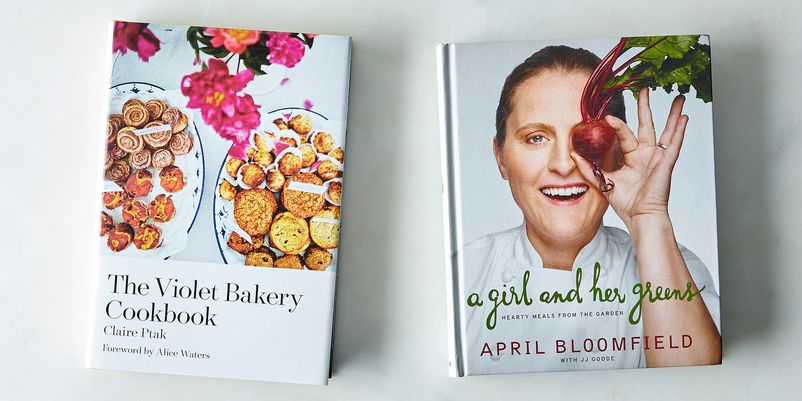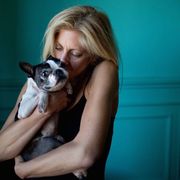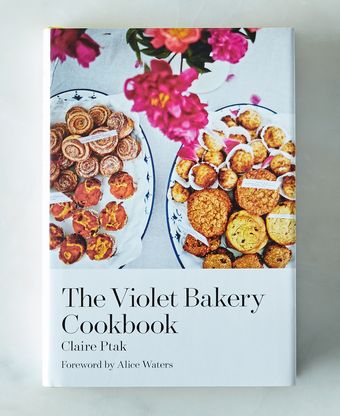When I got the two cookbooks, A Girl And Her Greens by April Bloomfield and The Violet Bakery Cookbook by Claire Ptak, I noticed that Bloomfield was a Brit working in America, and Ptak was an American working in London. What this means for those of you at home is that you can speak in an English accent when you are cooking from either of these books. The other thing is that—and no offense to my friends across the pond—but English food isn’t really known for being that great; I mean, no one ever says they’re going to England for the food. So if you make something from one of these two cookbooks and it comes out crummy you can be all: “It’s supposed to be, it’s ENGLISH FOOD!”
I always prepare people for any dishes I make to be unsatisfactory, because I’m a little bit of a nervous chef. But what I lack in skills I make up for with excuses. I have the smallest kitchen in New York City, and because of limited space, I’ve had to rid myself of many of the tools cooks can’t do without (like a Cuisinart, and an oven mitt, and a counter). Also, I’m a little bit poor, so I don’t like to buy spices that I’m only going to use once, though I did buy cardamom for one of Ms. Ptak’s recipes. The cashier at D’Agostino's thought the item was mismarked because $14.95 for a tiny jar of a spice that seems like it’s spelled wrong is excessive. I agreed with her, but explained to that I had to purchase it anyway, in the name of science.
Back to the books: Although my sainted and beloved daughter is named Violet, I am much more of a salad person than a cookie person, so I was certain the Bloomfield book was going to be my winner.
Oh wait, I’m not done with my excuses! Also: I’m not a “foodie.” I love to eat good food, but I cook a little like the people of yore (i.e. my mother). My first clue that I was unlike the cookbook writers is that no one seems to use the big cylinder of Morton salt. The ‘special salts’ are very big with these culinarians; kosher salt, “a flaky sea salt like Maldon,” fleur de sel. Do you know how many of those special salts I had before I started doing this? Zero. (No one seems to require Jane’s Krazy Mixed-Up Seasonings, which I do have.) I want you to know this because if I complain about not knowing what something is, you can refer back to this part and not think I’m just a run of the mill dummy. I am a self-aware dummy.
I decided to start with The Violet Bakery Cookbook because I recognized more of the recipes in there, and I was just more comfortable trying chocolate chip cookies. I know the standard Toll House recipe by heart, and here are the differences: Ptak's have a little more butter, more brown sugar than white, egg yolks only, and more salt (kosher, of course). I baked them; I loved them. They were big and buttery and crunchy. Then I adventurously moved on to the butterscotch blondies (I know, not a great leap from the chocolate chip cookies, but too bad). These made everyone in my house make the Homer Simpson donut noise. My only problem with them was that I didn’t have—and couldn’t find, in any store around me—the pan size she recommends (12- by 8-inch). I’m sure they’re on every street corner in London. I bought the closest thing I could find (about an inch smaller), and it made them extra gooey, but no complaints about that. They’re also covered in caramel shards, and I need to take a slight detour here to explain something (you might have to refer back to the dummy part now): My pet-peeve in recipes is when one of the ingredients has a page number next to it, thus directing you to ANOTHER RECIPE WITHIN THE RECIPE. For example:
125g (4 1/2 ounces) milk chocolate, broken into small pieces
75g (2 1/2 ounces) caramel shards (page 238)
Ptak’s blondie recipe had a recipe within a recipe, which caused me to faint dead away. Mostly when I see that, I just skip the thing entirely. Is it because I’m lazy? (Um, yeah, duh!) But in the case of the caramel shards, it was just putting water and sugar in a pan and then putting it on parchment paper (or as I like to call it, “aluminum foil”). So I was okay with that. But if it’s just that one little thing, why not leave it on the page I already have the book open to? What am I, made of bookmarks?
After the blondies, I moved on to her Chewy Ginger Snaps, which happen to be my favorite kind of cookie. These had two optional ingredients: coriander and paprika. I optioned out, only because when I opened the coriander I had, it looked like it was in some kind of X-files larval stage and the paprika I had was kind of brownish. (Note to self: Spices go bad.) I would’ve probably bought them except this was the recipe that I had already bought the million-dollar cardamom for. They were really good, but my own recipe from my friend Rebecca’s Grandma Polly is a little better, in my opinion—I’ve actually tried dozens of ginger molasses cookie recipes over the years, so I feel confident about this. I moved on to her Banana Buttermilk Bread recipe; the only ingredient I didn’t have was rum, but I bought a tiny airplane bottle of it which did not break the bank. I have been making the James Beard classic recipe since I was 10, but I liked this one even better. I made a few extra loaves and gifted them in “parchment paper.”
I have to say that moving to A Girl and Her Greens was welcome because I was finding it difficult to snap my jeans. Right off the bat, I was smitten with Bloomfield's prose. She has a very funny, authentic voice. She talks about being a “cranky knickers” boss, and waxes rhapsodic about vegetables in season—the latter took me right back to growing up in Katonah with our huge gardens full of perfect tomatoes (or in my Brit accent, tomahtoes). In the introduction, she talks about how much she likes her vegetables just “boiled in salty water and served with a glug of olive oil and a sprinkle of chile or a tender squeeze of lemon.” But that wouldn’t make much of a cookbook, she says, which is pretty honest and I tend to agree.
She talks a lot about finding the best vegetables and letting that determine what you are making; she recommends walking through the farmers market and selecting only what’s great. This turned out to be my biggest problem. Although I downloaded the Union Square Greenmarket app on my phone, I don't actually know how to find fabulous vegetables by sight, and it’s even more challenging in November in Manhattan. I mean if I see heirloom tomatoes (tomahtoes) in July at a farm stand in Vermont, I feel like they’re going to be good, but I cannot do that with anything else. This is why I have avocados in my kitchen that are either rocks or rotten.
So I went to the market and bought what I thought was good— asparagus—even though I know from experience that my parent’s asparagus is done by July. So maybe what I bought wasn’t asparagus… Anyway, I made the very delicious Tagliatelle with Asparagus and Parmesan Fonduta. Bloomfield says to “salt the water until it tastes slightly less salty than the sea.” As well as tasting good, it was impressive looking even though I didn’t make the pasta myself (recipe on page 127).
After that, I spent a week trying to figure out what else to make. At the last minute I went for her Salad Sandwich, which is essentially Pullman bread with lots of veggies and salad cream. It was lovely, though my mouth had some difficulty opening wide enough to get around it and I didn’t like the click my jaw made. Next recipe: Roasted Treviso with Breadcrumbs and Gorgonzola. Except I made it without Treviso, which is apparently a type of Italian radicchio that I couldn’t find anywhere. I just used radicchio. It was pretty nice even though the pine nuts required a mortar and pestle, which I don’t have because I’m not a turn-of-the-century-chemist.
The final recipe I wanted to try was Vegetable Crisps with Red Za’atar. (Other than overusing “Za” in Words with Friends, I had no idea what it was.) The special equipment required for this read like a who’s who of things I don’t own: deep fryer, check; mandoline, check; deep-fry thermometer, check; splatter screen, check; and a spider, which I do have in my bathroom, but I have the feeling that isn’t what she meant. So instead I read the recipe a lot, but didn’t make it—but I wish someone else would and send me some.
If I’d been testing A Girl and Her Greens in the summer and I had a great big kitchen full of equipment—and a different kind of spider—I would’ve championed it. As a book to read, I loved it: She is adorable and a riot and I even overlooked her having a dead pig around her shoulders on her first book cover. But making the food was just not working for me. I, along with my small kitchen and my one kind of salt, take responsibility for this, but I just kept going back to Ptak's book and cooking more and more. The recipes were familiar, but still interesting—which is why I will declare the winner The Violet Bakery Cookbook.



107 Comments
And here are some readers who enjoy food and things related to food. They enjoy all or some of these things: eating food, preparing food, reading about food, reading about the people who prepare it professionally and learning about where the unusual food comes from.
And these readers buy cookbooks, many more than they need. So many of them are reading the Piglet to see what's next for their enjoyment.
And you turned all this over to an airhead who:
1) thinks this is all a hoot, and
2) thinks it's a good opportunity to write about her wonderful self.
Whisky Tango Foxtrot
And here are some readers who enjoy food and things related to food. They enjoy all or some of these things: eating food, preparing food, reading about food, reading about the people who prepare it professionally and learning about where the unusual food comes from.
And these readers buy cookbooks, many more than they need. So many of them are reading the Piglet to see what's next for their enjoyment.
And you turned all this over to an airhead who:
1) thinks this is all a hoot, and
2) thinks it's a good opportunity to write about her wonderful self.
Whisky Tango Foxtrot
And here are some readers who enjoy food and things related to food. They enjoy all or some of these things: eating food, preparing food, reading about food, reading about the people who prepare it professionally and learning about where the unusual food comes from.
And these readers buy cookbooks, many more than they need. So many of them are reading the Piglet to see what's next for their enjoyment.
And you turned all this over to an airhead who:
1) thinks this is all a hoot, and
2) thinks it's a good opportunity to write about her wonderful self.
Whisky Tango Foxtrot
you guys need an edit button
Season of review might bias against certain seasonal books.
I, too, was offended by the comment about British food. This was a common perception/joke in the post WWII years because of how the cuisine had been reduced to its lowest common denominator by food rationing during the war and in the post-war recovery years. This hasn't been true for a very long time, and I wish people would get over it.
Order them at Penzeys. I am lucky enough to have a store within 5 miles of my house, and since they opened a few years ago, I have replaced all my spices with theirs. They are astonishingly potent and fresh, vastly cheaper as well as better than grocery store spices, and can be purchased in a number of sizes, including a small jar holding 1/4 cup. If you'd bought your ground cardamom at Penzeys, you'd have paid $8.55 for it. If you buy $30 worth of spices from them online, the shipping is free.
If you can manage to take a field trip to one of their stores, you will be able to smell each and every spice and herb they have. And they have everything you can think of, and plenty you've never heard of, except for ras el hanout. And your beloved, old-timey Jane's Mixed Up Seasonings, of course.